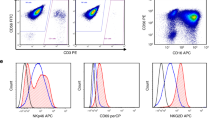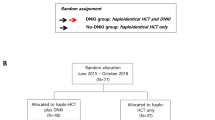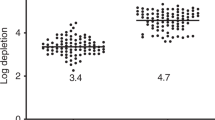Abstract
We performed a Phase I/II clinical trial to study the feasibility, toxicity and efficacy of allogeneic cytokine-induced killer (CIK) cell expansion, and treatment for patients with haematological malignancies who relapsed after allogeneic haemopoietic SCT (allo-HSCT). Allogeneic CIK cells were successfully generated for a total of 24 patients, including those from patients' own leukapheresis products in 5 patients who had no access to further donor cells. The median CD3+ T-cell expansion was 9.33 (1.3–38.97) fold, and CD3+CD56+ natural killer (NK)-like T-cell expansion was 27.77 (2.59–438.93) fold. A total of 55 infusions were done for 16 patients who had either failed or progressed after initial response to various individualized chemotherapy regimens and donor lymphocyte infusion (DLI), at doses ranging from 10 to 200 million CD3+ cells/kg. Response attributable to CIK cell infusion was observed in five patients. These included two with ALL, two with Hodgkin's disease (HD) and one with AML, and two of whom had a response sustained for more than 2 years. Acute GVHD occurred in three and was easily treatable. This study provides some evidence suggestive of the efficacy of allogeneic CIK cells even after failure of DLI in some cases.
This is a preview of subscription content, access via your institution
Access options
Subscribe to this journal
Receive 12 print issues and online access
$259.00 per year
only $21.58 per issue
Buy this article
- Purchase on Springer Link
- Instant access to full article PDF
Prices may be subject to local taxes which are calculated during checkout

Similar content being viewed by others
References
Collins Jr RH, Shpilberg O, Drobyski WR, Porter DL, Giralt S, Champlin R et al. Donor leukocyte infusions in 140 patients with relapsed malignancy after allogeneic bone marrow transplantation. J Clin Oncol 1997; 15: 433–444.
Kolb HJ, Mittermuller J, Clemm C, Holler E, Ledderose G, Brehm G et al. Donor leukocyte transfusions for treatment of recurrent chronic myelogenous leukemia in marrow transplant patients. Blood 1990; 76: 2462–2465.
Bloor AJ, Thomson K, Chowdhry N, Verfuerth S, Ings SJ, Chakraverty R et al. High response rate to donor lymphocyte infusion after allogeneic stem cell transplantation for indolent non-Hodgkin lymphoma. Biol Blood Marrow Transplant 2008; 14: 50–58.
Peggs KS, Thomson K, Hart DP, Geary J, Morris EC, Yong K et al. Dose-escalated donor lymphocyte infusions following reduced intensity transplantation: toxicity, chimerism, and disease responses. Blood 2004; 103: 1548–1556.
Lokhorst HM, Schattenberg A, Cornelissen JJ, van Oers MH, Fibbe W, Russell I et al. Donor lymphocyte infusions for relapsed multiple myeloma after allogeneic stem-cell transplantation: predictive factors for response and long-term outcome. J Clin Oncol 2000; 18: 3031–3037.
van de Donk NW, Kroger N, Hegenbart U, Corradini P, San Miguel JF, Goldschmidt H et al. Prognostic factors for donor lymphocyte infusions following non-myeloablative allogeneic stem cell transplantation in multiple myeloma. Bone Marrow Transplant 2006; 37: 1135–1141.
Kolb HJ, Schattenberg A, Goldman JM, Hertenstein B, Jacobsen N, Arcese W et al. Graft-versus-leukemia effect of donor lymphocyte transfusions in marrow grafted patients. Blood 1995; 86: 2041–2050.
Miller JS, Soignier Y, Panoskaltsis-Mortari A, McNearney SA, Yun GH, Fautsch SK et al. Successful adoptive transfer and in vivo expansion of human haploidentical NK cells in patients with cancer. Blood 2005; 105: 3051–3057.
Rubnitz JE, Inaba H, Ribeiro RC, Pounds S, Rooney B, Bell T et al. NKAML: a pilot study to determine the safety and feasibility of haploidentical natural killer cell transplantation in childhood acute myeloid leukemia. J Clin Oncol 2010; 28: 955–959.
Lu PH, Negrin RS . A novel population of expanded human CD3+CD56+ cells derived from T cells with potent in vivo antitumor activity in mice with severe combined immunodeficiency. J Immunol 1994; 153: 1687–1696.
Schmidt-Wolf IG, Negrin RS, Kiem HP, Blume KG, Weissman IL . Use of a SCID mouse/human lymphoma model to evaluate cytokine-induced killer cells with potent antitumor cell activity. J Exp Med 1991; 174: 139–149.
Schmidt-Wolf IG, Lefterova P, Johnston V, Scheffold C, Csipai M, Mehta BA et al. Sensitivity of multidrug-resistant tumor cell lines to immunological effector cells. Cell Immunol 1996; 169: 85–90.
Linn YC, Lau LC, Hui KM . Generation of cytokine-induced killer cells from leukaemic samples with in vitro cytotoxicity against autologous and allogeneic leukaemic blasts. Br J Haematol 2002; 116: 78–86.
Hoyle C, Bangs CD, Chang P, Kamel O, Mehta B, Negrin RS . Expansion of Philadelphia chromosome-negative CD3(+)CD56(+) cytotoxic cells from chronic myeloid leukemia patients: in vitro and in vivo efficacy in severe combined immunodeficiency disease mice. Blood 1998; 92: 3318–3327.
Introna M, Borleri G, Conti E, Franceschetti M, Barbui AM, Broady R et al. Repeated infusions of donor-derived cytokine-induced killer cells in patients relapsing after allogeneic stem cell transplantation: a phase I study. Haematologica 2007; 92: 952–959.
Laport GG, Sheehan K, Lowsky R, Shizuru JA, Stockerl-Goldstein K, Johnston LJ et al. Cytokine induced killer (CIK) cells as post-transplant immunotherapy following allogeneic hematopoietic cell transplantation. ASH Annu Meet Abstr 2006; 108: 412.
Porter DL, Levine BL, Bunin N, Stadtmauer EA, Luger SM, Goldstein S et al. A phase 1 trial of donor lymphocyte infusions expanded and activated ex vivo via CD3/CD28 costimulation. Blood 2006; 107: 1325–1331.
Cheson BD, Pfistner B, Juweid ME, Gascoyne RD, Specht L, Horning SJ et al. Revised response criteria for malignant lymphoma 5. J Clin Oncol 2007; 25: 579–586.
Estey E . Response in acute myeloid leukemia. Clin Adv Hematol Oncol 2008; 6: 113–117.
Niam M, Linn YC, Chong SF, Lim TJ, Chu S, Choong A et al. Clinical scale expansion of cytokine-induced killer cells is feasible from healthy donors and patients with acute and chronic myeloid leukemia at various stages of therapy. Exp Hematol 2011; 39: 897–903 e1.
Einsiedel HG, von Stackelberg A, Hartmann R, Fengler R, Schrappe M, Janka-Schaub G et al. Long-term outcome in children with relapsed ALL by risk-stratified salvage therapy: results of trial acute lymphoblastic leukemia-relapse study of the Berlin-Frankfurt-Münster group 87. J Clin Oncol 2005; 23: 7942–7950.
Gandhi V, Plunkett W, Weller S, Du M, Ayres M, Rodriguez CO et al. Evaluation of the combination of nelarabine and fludarabine in leukemia's: clinical response, pharmacokinetics, and pharmacodynamics in leukemia cells. J Clin Oncol 2001; 19: 2142–2152.
Virchis A, Koh M, Rankin P, Mehta A, Potter M, Hoffbrand AV et al. Fludarabine, cytosine arabinoside, granulocyte-colony stimulating factor with or without idarubicin in the treatment of high risk acute leukaemia or myelodysplastic syndromes. Br J Haematol 2004; 124: 26–32.
Rizzieri DA, Bass AJ, Rosner GL, Gockerman JP, Decastro CM, Petros WP et al. Phase I evaluation of prolonged-infusion gemcitabine with mitoxantrone for relapsed or refractory acute leukemia 4. J Clin Oncol 2002; 20: 674–679.
Kantarjian H, Thomas D, O'Brien S, Cortes J, Giles F, Jeha S et al. Long-term follow-up results of hyperfractionated cyclophosphamide, vincristine, doxorubicin, and dexamethasone (Hyper-CVAD), a dose-intensive regimen, in adult acute lymphocytic leukemia. Cancer 2004; 101: 2788–2801.
Wendelbo O, Nesthus I, Sjo M, Paulsen K, Ernst P, Bruserud O . Functional characterization of T lymphocytes derived from patients with acute myelogenous leukemia and chemotherapy-induced leukopenia. Cancer Immunol Immunother 2004; 53: 740–747.
Clark WB, Strickland SA, Barrett AJ, Savani BN . Extramedullary relapses after allogeneic stem cell transplantation for acute myeloid leukemia and myelodysplastic syndrome. Haematologica 2010; 95: 860–863.
Verneris MR, Ito M, Baker J, Arshi A, Negrin RS, Shizuru JA . Engineering hematopoietic grafts: purified allogeneic hematopoietic stem cells plus expanded CD8+ NK-T cells in the treatment of lymphoma. Biol Blood Marrow Transplant 2001; 7: 532–542.
Nishimura R, Baker J, Beilhack A, Zeiser R, Olson JA, Sega EI et al. In vivo trafficking and survival of cytokine-induced killer cells resulting in minimal GVHD with retention of antitumor activity. Blood 2008; 112: 2563–2574.
Introna M, Franceschetti M, Ciocca A, Borleri G, Conti E, Golay J et al. Rapid and massive expansion of cord blood-derived cytokine-induced killer cells: an innovative proposal for the treatment of leukemia relapse after cord blood transplantation. Bone Marrow Transplant 2006; 38: 621–627.
Marten A, Renoth S, von Lilienfeld-Toal M, Buttgereit P, Schakowski F, Glasmacher A et al. Enhanced lytic activity of cytokine-induced killer cells against multiple myeloma cells after co-culture with idiotype-pulsed dendritic cells. Haematologica 2001; 86: 1029–1037.
Ziske C, Marten A, Schottker B, Buttgereit P, Schakowski F, Gorschluter M et al. Resistance of pancreatic carcinoma cells is reversed by coculturing NK-like T cells with dendritic cells pulsed with tumor-derived RNA and CA 19-9. Mol Ther 2001; 3: 54–60.
Chan JK, Hamilton CA, Cheung MK, Karimi M, Baker J, Gall JM et al. Enhanced killing of primary ovarian cancer by retargeting autologous cytokine-induced killer cells with bispecific antibodies: a preclinical study. Clin Cancer Res 2006; 12: 1859–1867.
Tita-Nwa F, Moldenhauer G, Herbst M, Kleist C, Ho AD, Kornacker M . Cytokine-induced killer cells targeted by the novel bispecific antibody CD19xCD5 (HD37xT5.16) efficiently lyse B-lymphoma cells. Cancer Immunol Immunother 2007; 56: 1911–1920.
Marin V, Dander E, Biagi E, Introna M, Fazio G, Biondi A et al. Characterization of in vitro migratory properties of anti-CD19 chimeric receptor-redirected CIK cells for their potential use in B-ALL immunotherapy. Exp Hematol 2006; 34: 1219–1229.
Linn YC, Lau SK, Liu BH, Ng LH, Yong HX, Hui KM . Characterization of the recognition and functional heterogeneity exhibited by cytokine-induced killer cell subsets against acute myeloid leukaemia target cell. Immunology 2009; 126: 423–435.
Pievani A, Belussi C, Klein C, Rambaldi A, Golay J, Introna M . Enhanced killing of human B-cell lymphoma targets by combined use of cytokine-induced killer cell (CIK) cultures and anti-CD20 antibodies. Blood 2011; 117: 510–518.
Speiser DE, Romero P . Toward improved immunocompetence of adoptively transferred CD8+ T cells. J Clin Invest 2005; 115: 1467–1469.
Dudley ME, Wunderlich JR, Yang JC, Sherry RM, Topalian SL, Restifo NP et al. Adoptive cell transfer therapy following non-myeloablative but lympho depleting chemotherapy for the treatment of patients with refractory metastatic melanoma. J Clin Oncol 2005; 23: 2346–2357.
Acknowledgements
We are thankful to all nursing staff in the Department of Haematology for their assistance and expert nursing care. The project involving cellular therapy facility is funded by the Singapore Cancer Syndicate Grants TS39 and TS68. The clinical project is funded by the Singapore National Medical Research Council Grant NMCR/1097/2006.
Author information
Authors and Affiliations
Corresponding author
Ethics declarations
Competing interests
The authors declare no conflict of interest.
Additional information
Supplementary Information accompanies the paper on Bone Marrow Transplantation website
Supplementary information
Rights and permissions
About this article
Cite this article
Linn, YC., Niam, M., Chu, S. et al. The anti-tumour activity of allogeneic cytokine-induced killer cells in patients who relapse after allogeneic transplant for haematological malignancies. Bone Marrow Transplant 47, 957–966 (2012). https://doi.org/10.1038/bmt.2011.202
Received:
Revised:
Accepted:
Published:
Issue Date:
DOI: https://doi.org/10.1038/bmt.2011.202
Keywords
This article is cited by
-
Ex vivo expansion of natural killer cells for hematological cancer immunotherapy: a systematic review and meta-analysis
Clinical and Experimental Medicine (2022)
-
The progress and current status of immunotherapy in acute myeloid leukemia
Annals of Hematology (2017)
-
In-vitro influence of mycophenolate mofetil (MMF) and Ciclosporin A (CsA) on cytokine induced killer (CIK) cell immunotherapy
Journal of Translational Medicine (2016)
-
Immune checkpoint inhibitors enhance cytotoxicity of cytokine-induced killer cells against human myeloid leukaemic blasts
Cancer Immunology, Immunotherapy (2016)
-
A comparison between cytokine- and bead-stimulated polyclonal T cells: the superiority of each and their possible complementary role
Cytotechnology (2016)



